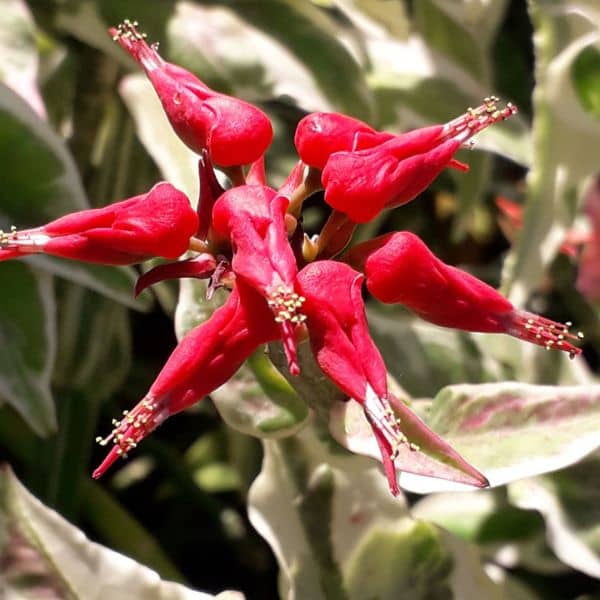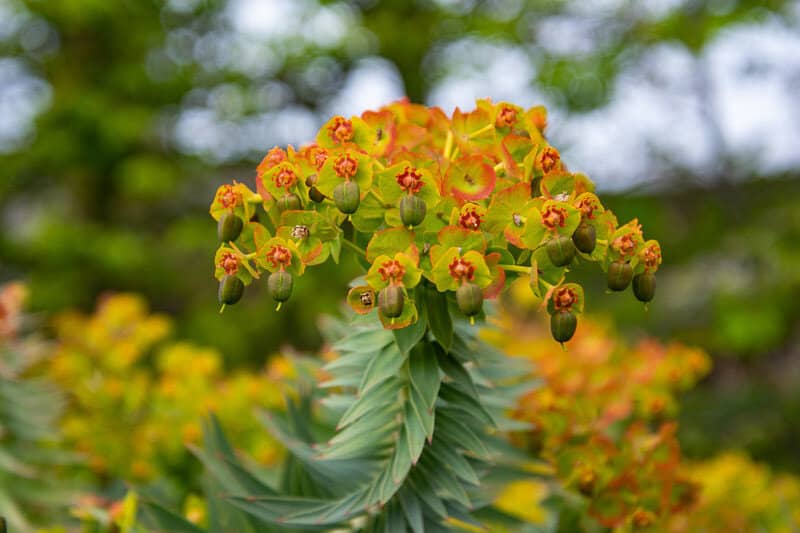Euphorbia is a diverse genus of flowering plants with about 2000 species in the Euphorniaceae family. These plants come in a variety of shapes and sizes, from small annual herbs to huge succulent shrubs and even trees. This plant has captured the attention of plant lovers and gardeners with its various types, and attractive features.
Through this article, we will discuss the tips for growing and caring for Euphorbia, explaining what is essential to its blooming beauty.
The Euphorniaceae family, which includes a wide variety of plants, includes succulents, shrubs, and even trees. While some species of euphorbia are native to the Americas and other parts of the world, most species of euphoria are found in Africa and Madagascar. Among many types, the poinsettia is one of the common types of euphorbia, that are not a succulent.
If you are thinking of growing euphorbia in your garden or as houseplants indoors, you need to understand the correct way how to plant, grow, and care for them.
Things to consider while growing Euphorbia: Care Tips
Appropriate Location
When planting Euphorbia, you should choose a location that receives bright indirect sunlight. Some plants, mainly succulent types can tolerate direct sunlight, however, they require proper care to avoid burning due to strong sunlight. Whereas, for other species, the afternoon sun might be helpful in hot conditions.
Planting in a Well Drained Soil
For the proper growth of the Euphorbia plant, use a little acidic, well-draining soil, and make sure the soil is not too wet, as it can cause root rot. For better drainage, use a potting mixture combined with perlite, sand, and potting soil.
Watering
Once established euphorbia can tolerant drought, but they need to be watered regularly, mainly during their growing season. While watering, make sure the soil is a bit dry, but don’t wait till it is completely dry. During the winter seasons, reduce watering when growth slows down.
Fertilizer
Euphorbia does not require much fertilization, but during their growing season, fertilize them once a month with a half-strength solution of balanced, water-soluble fertilizer. Many kinds of Euphorbia will flourish with a liquid fertilizer given throughout the growth season.
Likewise, plants grown in containers require more fertilizer than those grown in the ground.
When should you plant the Euphorbia?
When planting euphoria outdoors, wait till the risk of cold/winter has passed and plant them in spring. While, if you are thinking of planting them indoors, any time of the year is best for planting them, as for better growth, spring to early summer will be beneficial, when they can enjoy the longer days and more sunlight.
Types of Euphorbia
Some common and popular types of Euphorbia are listed below:
1. Euphorbia Milii (Crown of Thorns)
One of the common and popular types of Euphorbiaceae family is Euphorbia Milli, commonly known as Crown of Thorns, a resistant shrub that is native to Madagascar, and known for its vibrant flower in shades of red, pink, orange, yellow, or white and thorny stems.

While growing this, you need to place it in a that receives bright indirect sunlight, near a sunny window, avoid overwatering as it can lead to root rot, and let the soil dry out before watering.
2. Euphorbia Ingens
Euphorbia Ingens is a succulent tree originating from Southern Africa, commonly known as the Candelabra Tree or Cowboy Cactus, reaching up to a height of 30 feet. The leaves produced are small, deciduous, and often look like small-scale growing along stems.

This plant thrives in full sun to partial shade and prefers warm climates more. Plant it a well-draining soil like gravelly or sandy soil to avoid waterlogging and root rot.
3. Euphorbia Lactea
Euphorbia Lactea is a beautiful low-maintenance succulent, commonly known as Mottled Spurge, Dragon Bones Tree, or Candelabra Cactus, which has thick fleshy, and ribbed stems.

For the best growth of the plant, plant it in a spot that has full sun to moderate shade, and if grown indoors, make sure that it receives enough sunlight throughout the day. It prefers warm climates and doesn’t do well in colder climates.
4. Euphorbia Ammak

Euphorbia Ammak, also known as African Candelabra Tree or Desert Candelabra has a tree-like growth habit, with a single upright stem, that reaches a height of 30 feet. The stem has a narrow groove, going straight into its surface, and is often unbranched or rarely branched.
5. Euphorbia Ascot Rainbow
Another incredible succulent, also named African Candelabra Tree or Desert Candelabra is known for its shape, high height, and drought tolerance, which can reach a height of 30 feet.

While planting this plant, keep it in a location that receives full sun to partial shade, it prefers hot climates, to cold temperatures. Before watering, make sure the soil is completely dry.
6. Euphorbia trigona
Euphorbia Trigona is a common succulent from the central or West African regions often used in landscapes and a very easy-going succulent to grow and care for. It has beautiful architectural spikes on the main stems, which are usually green, sometimes with reddish or purplish colors.

It is popular for indoor plants and is a relatively low-maintenance plant. It requires well-draining soil and bright, indirect sunlight, also it does not need to be watered regularly and is drought tolerant.
7. Euphorbia characias
Euphorbia Characias, also called Mediterranean Spurge or Albanian Spurge, is a herbaceous perennial that usually grows to a height of three feet or more in bunches or groups.

This plant is drought tolerant and prefers full sun to moderate shade, and well-drained soil. Moreover, it is mostly used in ornamental gardens as the blooms are small and invisible, and the bracts add an instant of color.
8. Euphorbia Tithymaloides
Euphorbia Tithymaloides, scientifically called Devil’s Backbone, Redbird Cactus, Jacob’s Ladder, or Zigzag Plant is a member of the Euphorbiceace family, popular for its zigzagging stems. The thick, lance-shaped leaves appear the petals can be pink, red, green, or white in color.

You should be careful while handling the succulent stems as they contain a milky sap which can irritate your skin and be poisonous if eaten. For the proper growth of the plant, place it in a location that receives bright indirect sunlight, and does not do well in cold winters, as it can kill the plant.
9. Diamond Frost Euphorbia
Diamond Frost Euphorbia scientifically called Euphorbia hypericifolia ‘Inneuphe’, is a beautiful evergreen perennial. The narrow, widespread leaves vary in color from vibrant green to gray-green on the stems.

As this plant has a high tolerance for heat and humidity, it makes a good choice for gardens in warmer areas. Plant it in a location that receives full sun to partial shade, with well-draining soil.
10. Euphorbia rigida
Euphorbia rigida, called Gopher Spurge, or Silver Spurge native to Southern Europe and North Africa. This plant grows to 1 to 2 feet tall and its stems have narrow, bluish-gray leaves. Likewise, it has clusters of small, yellowish-green flowers at the tip of its stem from late winter to early April.

Like the other Euphorbia species, this plant also thrives well in full sun to partial shade. It is drought tolerant and grows well in poor, sandy, or rocky soil.
How to propagate Euphorbia?
The proper way to propagate Euphorbia can be done by following steps:
- Make a cutting using a sharp knife from a healthy stem, and let the cutting callus for a few days before planting in a potting mix that drains properly.
- Now, plant the leaf, and ensure the bottom of the leaf is lightly covered in the soil.
- Also, you can propagate through division, replant the bunches in separate pots after dividing them into smaller parts, and make sure each section has its own roots.
FAQs
1. What is Euphorbia used for?
The genus Euphorbia has a wide variety of plants, many of which have been used historically for various purposes, like ornamental purposes, some species of euphoria are treated as traditional medicine, also some of them are used as natural repellents to control pests.
2. Is Euphorbia a poisonous plant?
Some plants contain milky sap or latex, which can be extremely poisonous and irritating to the skin and eyes. Certain Euphorbia species can cause symptoms like nausea, vomiting, diarrhea, abdominal pain, and respiratory disease.
3. What is special about Euphorbia?
The genus Euphorbia has various unique characteristics, with vast diversity, more than 2000 species, ranging from small plants to huge tree-like succulents.
You may like to read more about, A Guide to Planting and Growing Peperomia
